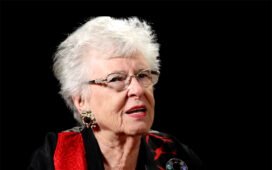(RNS) — Sometime during the pandemic, my husband, Bob, and I dreamed up a project: We decided to attend a different Shabbat service almost every Friday night — from the comfort of home. We began dropping in on congregations, mainly Reform, in locales stretching from Houston to Honolulu and from Tucson to Toronto. Following no rigid plan, we somewhat randomly picked and chose each week’s on-screen destination.
Thanks to technology, we tinkered with time zones. If we were running late, we looked westward to Mountain and Pacific Times, or, if running really late, we surfed the Union for Reform Judaism’s Alaska and Hawaii directories, where we came across the adorable domain names frozenchosen.org and shaloha.com.
We knew that no livestream could replace in-person services, where hugs in the aisles, greetings from wonderful rabbis, whispered chatter during the hakafot, and chitchat at the oneg are part of the package. As I said over a decade ago during my tenure as president of Congregation Beth Or in Maple Glen, Pennsylvania, we bond with a congregation when our feet cross the threshold.
Yet we also suspected that online worship could expand our horizons. About a month into our virtual travels, Bob said, and I concurred, “It’s such an honor to be able to see all this.” What we could not agree on was the title of this new ritual. He dubbed it “Shabbat Night in America,” while I favored “Sofa Shabbat.”
Our tour brought us to so many haimish places, including a down-to-earth service at Seattle’s Temple Beth Am, where the vivacious rabbi roved the aisles with her mic to encourage congregants to share joyful news; a Congregant of the Year Shabbat at Congregation Ner Tamid in Henderson, Nevada, where we were charmed by the tribute to the honoree, selected for photographing congregational life for over 40 years; and a stop at Temple Beth Jacob in Concord, New Hampshire, where my husband wished that he could enter its giant chocolate basket raffle.
Large congregations, we found, may have more resources than small and midsize ones, but they do not have a monopoly on spirit. As an example of a small congregation with ruach, we couldn’t have asked for a lovelier service than at Boise’s Ahavath Beth Israel, led by Rabbi Daniel Fink, a 13th-generation rabbi who, now emeritus, in 1994 became Idaho’s first full-time rabbi.
Regardless of size, we preferred services that grappled with topical matters over those that offered feel-good escapism. On particularly newsworthy weeks, our quest for relevance drew us to headline-making locations. In August, for example, following the Democratic National Convention in Chicago, we turned to the host city’s Temple Shalom for reflections.
We often watched services dictated by the calendar. One of our favorites was the annual Martin Luther King Jr. Shabbat in Atlanta, held at The Temple jointly with Ebenezer Baptist Church. It was a pleasure listening to the combined choirs’ uplifting music and the sermon by U.S. Senator Reverend Raphael Warnock — not to mention seeing my brother, then president of The Temple, on the bimah.
At a Refugee Shabbat at San Francisco’s Congregation Sherith Israel sponsored by HIAS (formerly the Hebrew Immigrant Aid Society), two speakers who had fled Ukraine offered moving remarks. At a Pride Shabbat at Salt Lake City’s Congregation Kol Ami, the cantor sang “Somewhere Over the Rainbow” as a rainbow-colored challah graced the bimah.
We occasionally tuned in to my childhood congregation, Temple Israel in Memphis, Tennessee, to share, as best we could from afar, a service that my mother and other family members were attending on-site.
That was only the beginning of Jewish geography: Popping in on a temple in Overland Park, Kansas, I realized that my great-grandmother, of blessed memory, had grown up there. We were delighted to hear our home congregation’s beloved cantor emeritus, David Green, at a temple in New Jersey. Researching Wise Temple in Cincinnati, we discovered that Bob’s sister, may her memory be a blessing, contributed to the Wikipedia article on the history of the Jews in that birth city of Reform Judaism in America.
My recommendation, especially at this holiday season when Jews start anew, is to take some e-journeys. While you’re at it, explore the chosen congregation’s “About Us” page and click on some links on the community’s Wikipedia page. Houses of worship provide a glimpse of their past, a snapshot of their present, and a window into the surrounding community.
Aim for a broad array of picks, ranging from historic temples such as Congregation Mickve Israel in Savannah, Georgia, founded in the 1730s and calling its majestic Gothic sanctuary home since 1878, and younger congregations such as Temple Rodef Shalom in Falls Church, Virginia, born in the latter half of the 20th century.
If you’re so inclined, seek out services that may shed light on current events and hot-button issues. While Shabbat is indeed a source of comfort, it is also a prime opportunity to confront the weighty subjects and commemorate the occasions that inform the other six days and call us to mend our world.
Not to worry, you’ll be welcome: Many congregations make it a point to include the remote community, such as by displaying written lyrics and liturgy on the screen. When we went to the livestream of Temple Isaiah in Fulton, Maryland, our friend Rabbi Craig Axler thoughtfully checked for comments in the online chat as well. As the rabbi at Congregation Schaarai Zedek in Tampa, Florida, said, “When you choose to bring our service into your home, your home becomes an extension of our sanctuary.”
You may discover, as we did, these twin truths:
Above all, there is no substitute for in-person worship. When we enter the doors of Beth Or, our family’s longtime home away from home, the sense of community is palpable. Services are meant to be experienced in a shared space. That is hard to recreate between couch and screen.
And services are just the icing on the apple cake. Showing up is the way to till the community garden, study Torah, sing in the choir, cook in the temple kitchen, kvell over students’ mitzvot, kibitz in the parking lot after meetings, and so much more. How better to pray with our feet than to be present.
But there is also no equivalent for the accessibility and Jewish literacy that Sofa Shabbat brings. “If the internet had been invented 3,000 years ago,” my husband quipped, “they might have set the whole thing up this way to begin with.”
Technology serves its highest purpose when embracing folks who may not otherwise be able to attend. And for all viewers, it is at once heartwarming to encounter familiar tunes and traditions and interesting to notice new twists.
We enjoyed this virtual ritual so much that we have not stopped. A few states and a lot of congregations remain.
As between the two ways of observing Shabbat, we do not need to choose. Going forward, on some Shabbats we will be Jews in the pews, and on others we will be Jews who kick off our shoes.
(Jan Zauzmer is a children’s book author and a past president of a large Union for Reform Judaism congregation. The views expressed in this commentary do not necessarily reflect those of Religion News Service.)















